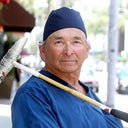I had a rhinoplasty over 2 years ago. Do I have a polly beak deformity or is my tip just too full. I have very thick skin and if I have a polly beak deformity I definitely feel it is a soft tissue and scar tissue problem. Would steroids be an option to reduce the tip? Or fillers to bring my bridge up more so the tip doesn't look as large? I feel the lower bridge might just be giving the illusion of a larger tips so maybe I should fill it in. I want to avoid surgery. Any helpful suggestions?
Answers (7)
From board-certified doctors and trusted medical professionals
Dr. Toby Mayer, MD

Dr. Toby Mayer, MD
Board Certified Facial Plastic Surgeon
Answer
Dr. Sunny Park, MD, MPH
Dr. Sunny Park, MD, MPH
Board Certified Facial Plastic Surgeon
Answer
Dr. William Portuese, MD
Dr. William Portuese, MD
Board Certified Facial Plastic Surgeon
Answer
Dr. Victor Chung, MD
Dr. Victor Chung, MD
Board Certified Facial Plastic Surgeon
Answer
Dr. Arian Mowlavi, MD, FACS (license on probation)
Dr. Arian Mowlavi, MD, FACS (license on probation)
Board Certified Plastic Surgeon
Answer
Dr. Michael Elam, MD (retired)
Dr. Michael Elam, MD (retired)
Board Certified Otolaryngologist
Answer
Dr. Oleh Slupchynskyj, MD, FACS (retired)
Dr. Oleh Slupchynskyj, MD, FACS (retired)
Board Certified Facial Plastic Surgeon
Answer
More Revision Rhinoplasty Questions
See all Revision Rhinoplasty Q&AWE SEND PRETTY
EMAILS
What’s trending? Who’s turning heads? Which TikTok myths need busting? We’ve got you. No fluff, no gatekeeping—just real talk. Get our free, unfiltered newsletter.